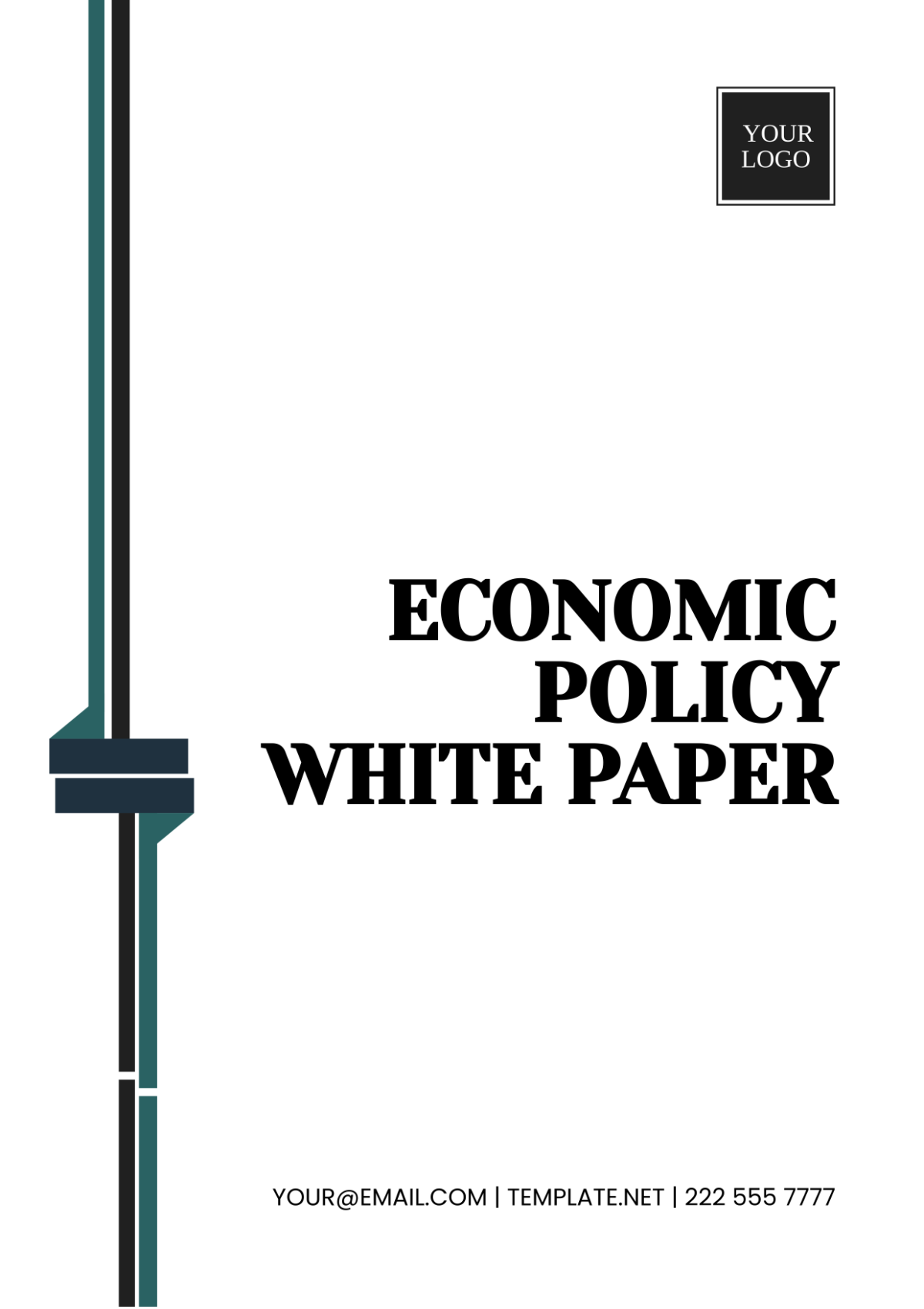ECONOMIC POLICY WHITE PAPER
I. Executive Summary
The executive summary offers a concise overview of the economic landscape, highlighting key findings and recommendations. It underscores the importance of informed policymaking in addressing economic challenges and fostering sustainable growth.
Amidst the evolving dynamics of the global economy, [Your Country Name] stands at a critical juncture marked by unprecedented opportunities and significant challenges. This white paper presents a thorough analysis of prevailing economic trends, assesses existing policy frameworks, and proposes evidence-based recommendations to steer policymakers and stakeholders toward effective decision-making.
A. Key Findings:
Despite robust GDP growth averaging [Percentage] over the past decade, lingering structural impediments and external uncertainties pose significant risks to sustained economic expansion.
Persistent disparities in income distribution and inefficiencies within the labor market threaten social cohesion and long-term prosperity.
The intersection of environmental degradation and climate change exacerbates economic vulnerabilities, highlighting the urgent need for sustainable development strategies.
II. Introduction
The introduction sets the stage by contextualizing the current economic environment, shedding light on the opportunities and obstacles facing policymakers and stakeholders.
Amid a rapidly evolving global economic landscape, Your Country finds itself at a pivotal juncture, poised to navigate a complex array of economic challenges and opportunities. The convergence of technological disruptions, geopolitical shifts, and environmental pressures underscores the imperative for proactive policy interventions to safeguard economic stability and foster inclusive growth.
This white paper endeavors to provide a comprehensive understanding of the macroeconomic landscape, delineate key policy priorities, and chart a course of action to propel [Your Company Address] towards a more resilient and prosperous future. By leveraging empirical evidence and best practices, we aim to equip policymakers and stakeholders with the insights and tools necessary to navigate the intricacies of economic policymaking and steer the nation toward sustainable development pathways.
III. Macroeconomic Analysis
A. Economic Trends
Overview
The economic landscape exhibits moderate growth, with GDP expanding by 3.2% in the last fiscal year. However, persistent inflationary pressures and rising unemployment rates pose significant challenges.
Sectoral Analysis
The services sector remains the primary driver of economic activity, contributing 55% to GDP. Meanwhile, the manufacturing sector grapples with sluggish growth due to supply chain disruptions and weakening global demand.
B. Policy Evaluation
Existing Policies
Impact Assessment
Recent adjustments to monetary policy, including a reduction in interest rates, have had a marginal impact on stimulating consumer spending and business investment. However, structural bottlenecks and regulatory hurdles impede the transmission mechanism of monetary policy.
IV. Economic Challenges
A. Structural Issues
Labor Market
Despite efforts to upskill the workforce, labor market participation remains suboptimal, particularly among youth and women. Addressing skills mismatches and enhancing vocational training programs are imperative to unlock the full potential of the labor force.
Income Inequality
Income inequality continues to widen, exacerbating social disparities and dampening overall economic growth. Policies aimed at promoting inclusive growth, such as progressive taxation and targeted social welfare programs, are essential to mitigate this trend.
B. External Factors
Global Economic Uncertainty
Escalating trade tensions and geopolitical conflicts pose significant risks to global economic stability. As a small, open economy, Newlandia is vulnerable to external shocks, necessitating a proactive approach to risk management and diversification.
Environmental Challenges
V. Policy Options
A. Monetary Policy
Interest Rates
Quantitative Easing
While quantitative easing measures have provided liquidity support to financial markets, caution should be exercised to prevent asset price bubbles and inflationary pressures. Targeted interventions, such as asset purchases focused on productive sectors, can maximize the impact of quantitative easing on real economic activity.
B. Fiscal Policy
Government Spending
Increased government spending on infrastructure projects, education, and healthcare can catalyze economic growth and job creation. Public-private partnerships should be leveraged to mobilize additional resources and ensure the efficient allocation of funds.
Taxation
VI. Recommendations
Implement targeted labor market reforms to enhance workforce participation and address skills shortages.
Strengthen social safety nets and invest in human capital development to reduce income inequality and promote social cohesion.
Foster international cooperation and diversify trade relations to mitigate the impact of global economic uncertainties.
Accelerate the transition to a low-carbon economy through regulatory incentives and green investment initiatives.
Adopt a holistic approach to economic policy-making, integrating monetary, fiscal, and structural reforms to achieve balanced and inclusive growth.
Prioritize investments in human capital development and skills training to enhance workforce productivity and mitigate income inequality.
Implement targeted fiscal stimulus measures to support vulnerable sectors and foster innovation-led growth.
Strengthen regulatory frameworks to incentivize green investments and promote environmental sustainability.
Foster international cooperation and engage in multilateral trade agreements to mitigate the adverse impacts of global economic uncertainties.
VII. Conclusion
In conclusion, this white paper underscores the importance of evidence-based policymaking in navigating complex economic challenges. By implementing the recommended policy measures in a coordinated manner, Newlandia can foster economic resilience, promote social inclusion, and achieve sustainable development.
Prioritize investments in human capital development and skills training to enhance workforce productivity and mitigate income inequality.
Implement targeted fiscal stimulus measures to support vulnerable sectors and foster innovation-led growth.
Strengthen regulatory frameworks to incentivize green investments and promote environmental sustainability.
Foster international cooperation and engage in multilateral trade agreements to mitigate the adverse impacts of global economic uncertainties.
White Paper Templates @ Template.net






























